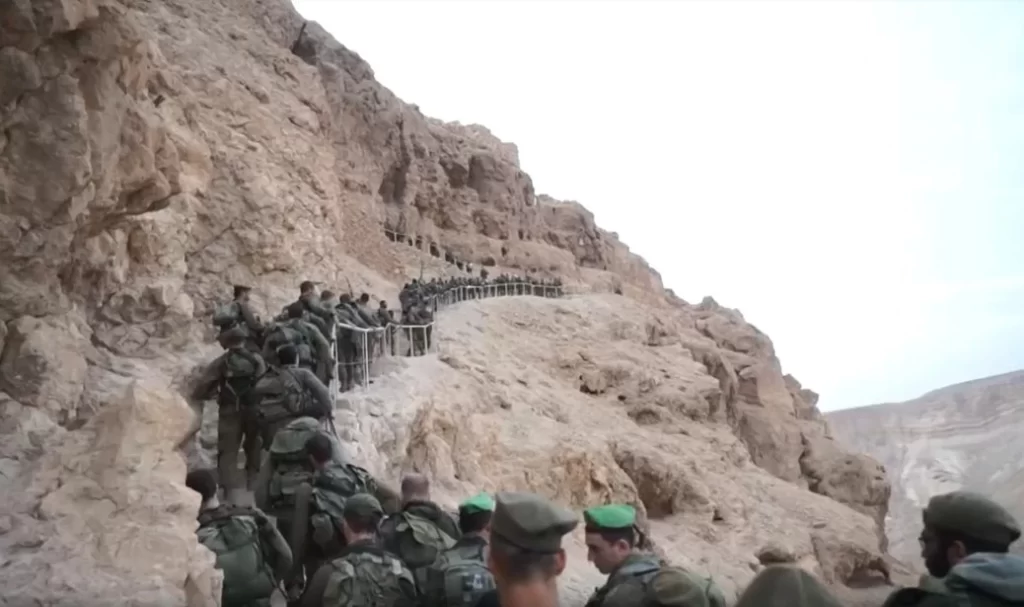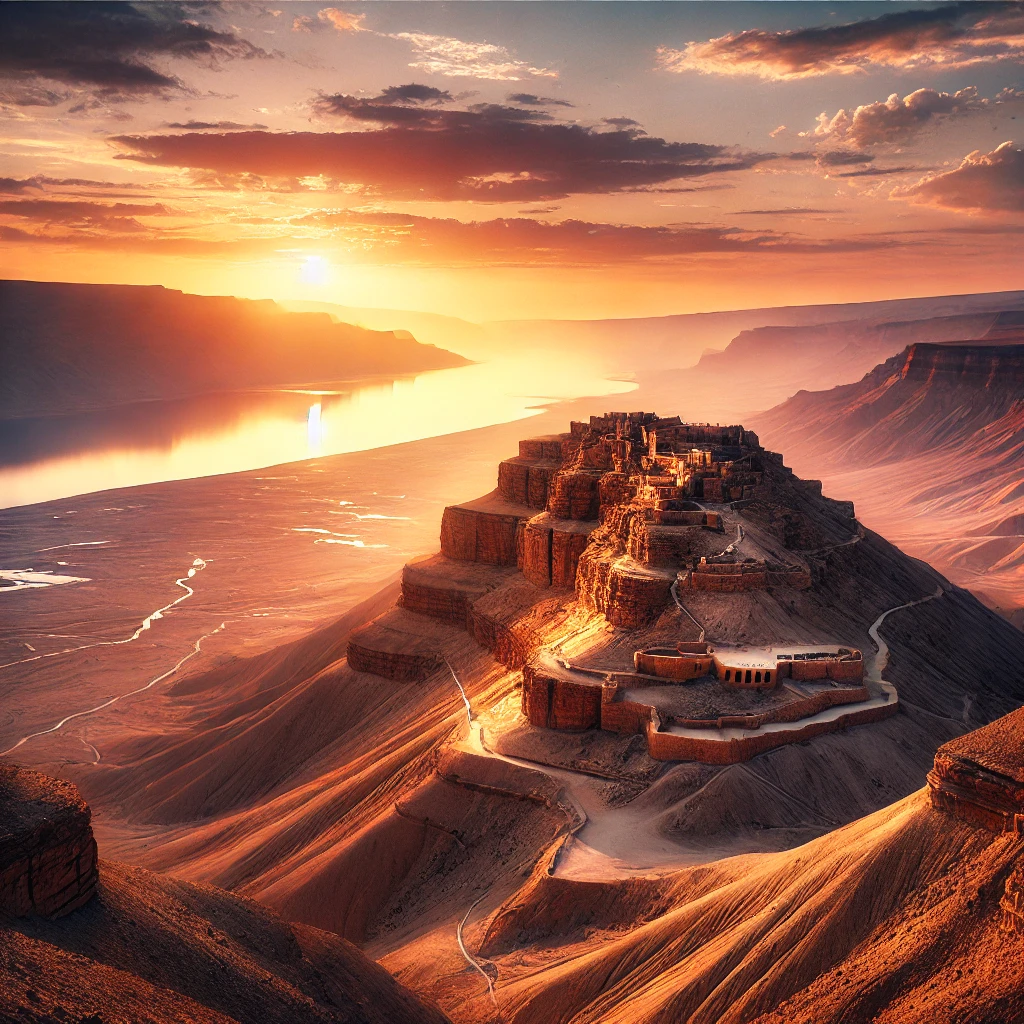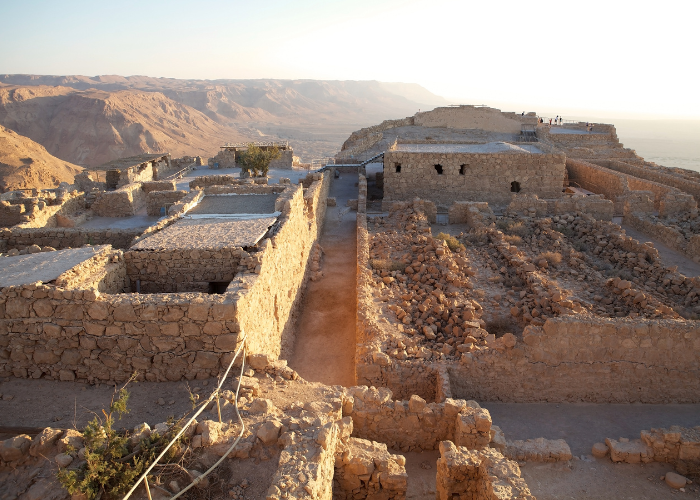Masada, a fortress nested high on a plateau overlooking the Judean Desert and the Dead Sea, is one of Israel’s most famous historical landmarks. It has fascinating history and you can experience it through a scenic hike along the Snake Path, or a more comfortable ride on the cable car. visiting Masada is a must for both history buffs and adventure seekers alike.



The Fascinating History of Masada, Israel
Masada holds a special place in Jewish history, known as the last stand of the Jewish resistance against Roman forces. The fortress was originally constructed by King Herod in the first century BCE as a lavish winter palace. Herod, fearing threats to his rule, built Masada not only as a refuge but also as a symbol of power, complete with storerooms, palaces, and an elaborate water system.
However, Masada’s most famous chapter unfolded in 73-74 CE during the Jewish-Roman War. After the fall of Jerusalem in 70 CE, a group of Jewish rebels, known as the Sicarii, fled to Masada. For three years, they resisted the Roman siege. When Roman forces finally breached the fortress using a massive ramp, the defenders chose to die by suicide rather than face capture. This dramatic event has made Masada a symbol of Jewish perseverance and determination, and it remains an important site of national heritage for Israel today.
Masada -a UNESCO World Heritage Site
In 2001, Masada was recognized as a UNESCO World Heritage Site due to its outstanding historical, cultural, and architectural significance. The site is considered an exceptional symbol of ancient human ingenuity, with its sophisticated water system and well-preserved ruins offering insight into the life of King Herod and the Jewish rebels who later occupied the fortress. UNESCO’s designation also underscores the importance of Masada’s role in Jewish heritage and its influence on modern historical memory.
Exploring the Masada Israel Snake Path: What to Expect
One of the highlights of visiting Masada is the chance to hike the Snake Path, a winding trail that ascends from the base of the mountain to the fortress above. The trail earned its name due to its serpentine route, curving sharply as it climbs the steep slope of the plateau.
The hike is moderately challenging, covering around 2 kilometers (1.25 miles) and taking most visitors between 45 minutes to 2 hours depending on fitness levels. It’s best to start early, especially during the summer months when temperatures soar. Along the path, hikers are rewarded with stunning views of the surrounding desert and the Dead Sea.
For those less inclined to hike, there is also a cable car that runs from the base to the summit, offering panoramic views without the physical effort.
Tips for Hiking the Snake Path:
- Start at sunrise to avoid the heat and catch incredible views as the sun rises over the Dead Sea.
- Bring plenty of water, as the desert heat can be intense, especially in the summer.
- Wear comfortable shoes and a hat, and don’t forget sunscreen!
*Interesting fact- The soliders of the Nahal brigade finish their final journey before getting qualified as combat fighters at Masada

Masada Israel Weather: What to Expect Year-Round
Masada is located in the Judean Desert, and as you might expect, the weather can be extreme. Summers (June to September) are very hot, with daytime temperatures often exceeding 40°C (104°F). Winter months (December to February) are much milder, with daytime temperatures ranging from 10°C to 20°C (50°F to 68°F), making it the most comfortable season for hiking and sightseeing.
Visitors should be aware that even in winter, nights can be quite chilly due to the desert climate, so it’s wise to bring layers.
Seasonal Overview:
- Summer: Scorching hot, best for early morning or late afternoon visits.
- Winter: Ideal for daytime visits, with cooler temperatures and more comfortable conditions for hiking.
- Spring and Fall: Moderate temperatures, making these transitional seasons great for a visit with fewer crowds.
Best Times to Visit Masada: When to Plan Your Trip
The best time to visit Masada is during the cooler months, from October to April. During this period, the weather is pleasant, making it easier to hike the Snake Path and explore the fortress without being overwhelmed by the heat.
Additionally, visiting early in the morning or late in the afternoon, regardless of the season, will not only provide a cooler experience but also offer the best lighting for photography, especially with views over the Dead Sea.
Key Considerations:
- Peak Tourist Season: December through February, especially around major holidays like Christmas and Hanukkah, tends to attract more visitors.
- Off-Peak: Late autumn (October-November) and early spring (March-April) offer pleasant weather with fewer crowds.

Tips for Visiting Masada: Must-See Spots and Practical Advice
1. The Roman Ramp: If you prefer a less strenuous hike or are approaching Masada from the west, consider hiking up the Roman Ramp, a shorter and easier trail used by Roman soldiers during the siege.
2. The Northern Palace: Explore Herod’s three-tiered Northern Palace, which offers incredible views of the Dead Sea and showcases the impressive architectural and engineering skills of the time.
3. The Synagogue and Bathhouses: Visit the ancient synagogue and the Roman-style bathhouses for a deeper dive into life at Masada during both the Herodian and the rebel periods.
4. The Masada Museum: Before heading up the mountain, stop at the Masada Museum at the visitor center, where you can see artifacts from the site and learn more about the history through multimedia presentations.

Practical Tips:
- Getting There: Masada is easily accessible by car or bus from Jerusalem, Tel Aviv, or Eilat. Most visitors enter from the eastern side (near the Dead Sea), but the western approach is also an option. You can book a tour from trusted tour guides here==>
- Entry Fees: There is a fee to enter the Masada National Park (at the time of writing this it is 31NIS for adult and 17NIS for kids), with additional costs for the cable car. Guided tours are also available at the site.
- Facilities: There is a visitor center with restrooms, a café, and a gift shop at the base of the mountain.
Ready to Visit?
Whether you’re captivated by ancient history or eager to experience the breathtaking views from the summit, Masada is a site that blends natural beauty with profound historical significance. You can also combine it with your trip to the dead sea as it is only 25 minute drive. Have you already been in Masada? Let us know in the comments!
FAQ
Masada is located in the Judean Desert, close to the Dead Sea. It can be accessed by car or bus from major cities like Jerusalem, Tel Aviv, and Eilat. The eastern entrance (near the Dead Sea) is the most common, but you can also reach Masada from the west, using the Roman Ramp entrance.
The best time to visit is during the cooler months, from October to April. Visiting early in the morning or late in the afternoon will help you avoid the desert heat and enjoy fewer crowds, especially if you plan to hike the Snake Path.
The hike up the Snake Path usually takes between 45 minutes to 2 hours, depending on your fitness level and how often you stop to rest. It’s a steep and winding trail, so make sure to bring water and wear comfortable shoes.
Yes, Masada is family-friendly. While younger children might find the Snake Path challenging, they can enjoy the cable car ride and explore the historical ruins at the top. There are also informative displays at the visitor center and museum to engage children.
